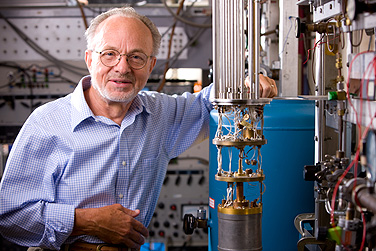Close Up
Gasparini oversees growth in physics

Since 1976, Francis Gasparini has received as a single investigator more than $2.7 million of funding from the National Science Foundation spanning a period of 33 consecutive years. Photo: DOUGLAS LEVERE
The Department of Physics has made significant strides under the leadership of UB Distinguished Professor Francis Gasparini. During his five years as chair, the faculty and student populations have grown to their highest totals, while the department has developed cutting-edge, interdisciplinary research programs in new materials, nanoscience, quantum devices, biological physics, complex systems, cosmology and high-energy physics.
“The strength of the department now is in the quality and number of its young faculty,” Gasparini says. “A good number of them have already been promoted, and they have shown high quality in their leadership and ability to get grant funding. To me, now is the highest peak in the quality and promise of the department.”
When he joined the department in 1973, Gasparini notes that a fragmented situation existed—physics was spread across three different buildings on the South Campus. “The department was not adequate, but there was this great promise of the university moving to the North Campus and the physics building (Fronczak Hall) was already designed and being built. There was great promise in terms of potential hires, but one of the difficulties of hiring in any science or engineering department is that you require a substantial amount of money to buy equipment.”
Some of that promise came to fruition, but it has only been in the past five years that the department has reached the level of what Gasparini would call respectable in terms of size and commensurate with teaching obligations. A high point of 32 faculty members was reached two years ago. The faculty currently is at 28 due to retirements, but replenishment is in progress.
The growth of the physics student population also has taken place, along with a large increase in postdoctoral researchers. “For many years we had very few postdoctoral researchers because you need a substantial stipend to pay them, so this again speaks to the quality of the faculty we have and their ability to get funding for this purpose.”
Gasparini’s passion for physics started when he was very young, growing up in Italy and emigrating with his family to the U.S. in 1956. “I don’t think there was ever an alternative career route for me,” he says.
His research focus over the years has been concentrated on quantum fluids and phase transitions. Liquid helium-4 and helium-3 are the only substances that remain liquid at absolute zero and exhibit very unusual quantum properties. His training as a graduate student was done at the University of Minnesota and, as a postdoctoral fellow, at Ohio State.
Since 1976, Gasparini has received as a single investigator more than $2.7 million of funding from the National Science Foundation spanning a period of 33 consecutive years, a unique accomplishment.
“I feel fortunate that this work has been recognized. The funding has allowed me to train 14 PhD students and 14 master’s students,” he says. “During these years, I’ve had 30 to 35 undergraduates work in my laboratory, and a good number of them went off to graduate school. There have been a lot of people involved in this research.”
His most recent area of research asks the following question: if one takes a material and makes it progressively smaller, how does it behave before it becomes of atomic size?
“We call this the non-thermodynamic, or mesoscopic limit,” he explains. “There have been many theories as to what should happen, depending on the system, and in particular near a phase transition. We have dedicated the last 10 to 20 years to try to answer this. This understanding of the ‘small’ branches off into many other directions in physics.
“I don’t think you can make a device out of the things that we study. But if you map the understanding of this to the understanding of the Bose-Einstein condensate—which is the study of gases condensed into a ground state at very low temperatures—there are suggestions that you can actually look at these condensates as a means of doing quantum computing,” says Gasparini.
One application could result in the understanding of the limitations in magnetic data storage as the basic bit of information is decreased in size.
Gasparini is encouraged with the path that the university has taken. “I think we’re back on track of recognizing academic excellence as a quality to strive for,” he observes. “The vision of our president is an excellent one. There’s a plan for the future and proposals like UB 2020 and the strategic strengths show us how to get there. I’m really optimistic, in spite of the present financial restraints.”
Buffalo is also a plus factor for Gasparini. “I went through a phase when I first moved here of somehow feeling not very positive, but that was really silly. I’ve traveled all over the country and there are positives and negatives everywhere. I make no apologies for Buffalo—it’s an excellent place to live. It’s accessible, with good schools, and a certain friendliness about living here. I’m perfectly happy here and don’t intend to move when I retire.”
Gasparini is an avid cyclist who takes advantage of the area’s conducive cycling routes, occasionally riding tandem with his wife, Lucille. The couple, who reside in Williamsville, also enjoy the theater. Their son, Francis Jr., is a producer of TV reality shows in Los Angeles, and daughter, Nicole, who graduated from UB’s honors program, is a faculty member at Tulane University.

Reader Comments